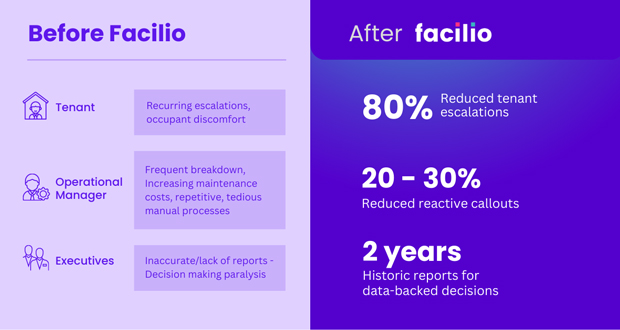 In an exclusive interview with FMJ, Sumith Sukumaran, Operations Manager at Quality FM Group, Dubai talks about how they transformed their portfolio operations with an agile, modern connected CaFM / CMMS solution.
In an exclusive interview with FMJ, Sumith Sukumaran, Operations Manager at Quality FM Group, Dubai talks about how they transformed their portfolio operations with an agile, modern connected CaFM / CMMS solution.
The common discussion in the industry these days is that there’s a huge latency between legacy CaFM tools and the state of building operations today. Are the current breed of tech tools equipped to help modern O&M teams succeed?
Any system is only as good as the people who use it. The complexity of legacy tools stands in the way of field teams using them to their full potential. So to answer your question, I would say no. What they need is an easy-to-navigate user interface that works seamlessly on their phone or tab. Bloated systems which don’t allow the flexibility of adding or removing modules turn out to be expensive and resource intensive.
Most legacy systems run on proprietary communication protocols or are simply not built to function seamlessly across other data management platforms. This limits their cross-functional communication capability a lot. The role of FM & O&M teams is going through a shift, where they are taking on more strategic roles. Most of the tools in the market don’t support this shift.
What are the biggest downsides to using legacy systems for O&M?
Irrespective of the organisation size, users want solutions that can seamlessly integrate into their existing processes under one digital ecosystem. This is no longer optional.
There are multiple stakeholders such as tenants, vendors, technicians and managers who need to access the system and pull data to make decisions and execute on them. The current breed of legacy tools lack the features to make this happen.
As the use cases increase and databases get bigger, since these systems function in silos, fetching, migrating and mapping data into a single environment without errors gets complicated. As more functions are integrated and more functions go digital, there are also security risks we need to consider.
So your typical CaFM/CMMS system simply won’t cut it. What we need is a cloud-based solution that can become a single source of truth for all stakeholders.
Can you walk us through your journey of switching to a modern CaFM system and what were the key considerations you had that helped you make the decision?
We were using an in-house CaFM platform in the past, and over time started seeing critical shortcomings. These were negatively impacting business outcomes. We had the option of either overhauling the existing system at a high cost which would be time-intensive, or look for another solution in the market.
We wanted a flexible solution that would scale and adapt to our business rather than the other way round. We should be able to customise workflows without affecting the system fundamentals.
We finally chose Facilio – their plug & play solution along with a drag and drop interface made deployment fast and easy. Reports could be easily shared with multiple stakeholders. Modules & functionalities could be scaled up or down as per the business needs. So we pay only for what we use.
The biggest problem with legacy solutions is the bloat – we use less than 80% of the system but pay for all of it.
What would you say is the most valuable criteria of a modern CaFM solution? Is it collaborative stakeholder engagement, or process improvements or interoperability?
There is no straight answer to this since all of them are interlinked and cannot be isolated from each other. We actually need a platform that connects people, processes, and systems—so we can effectively achieve all of these.
However, if I were to rank them in terms of time to value, I would pick the process improvements first, then the interoperability and finally collaborative stakeholder engagement.
How do you measure the success of your new CaFM implementation? Could you give us an example of how it connected people, processes & systems?
We deployed the solution in 2020, during the first COVID wave, and the solution ensured seamless delivery of services. During the lockdowns, despite teams being in different locations, everyone involved including the senior management got real time insights.
As soon as we migrated to the new system, we saw a steep drop in customer escalations, up to 80%. The reactive call volumes decreased by 30% across all the properties. Preventive maintenance, compliance and asset life optimisation have steadily improved since then. Staff efficiency has significantly increased and we now have a happier workforce. We now have access to two years of data which helps us make data-informed decisions – this is of the utmost importance and value to us.
For more information visit https://facilio.com
-ends-
To have your industry news published in the pages of FMJ’s news section, Month in FM, and here online on fmj.co.uk, please send your news and image to Danny Grange danny.grange@kpmmedia.co.uk
The view or information contained within these unedited press releases, are that of the company producing it and not necessary the views of kpm.





